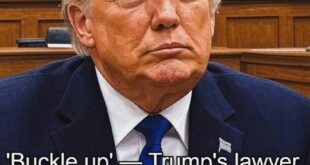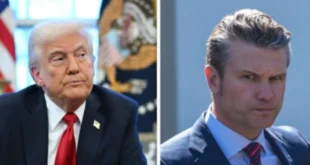WALL STREET’S GREAT REVERSAL: LEADING ECONOMIST ADMITS TRUMP’S TARIFF STRATEGY MAY BE BRILLIANT AS MARKETS SOAR TO RECORD HIGHS
The financial world experienced a moment of profound recalibration last Friday as stock markets reached unprecedented heights, forcing one of Wall Street’s most prominent economists to publicly acknowledge that President Donald Trump’s controversial tariff strategy may represent a masterpiece of economic statecraft rather than the reckless protectionism that critics initially condemned. This dramatic shift in perspective comes as the administration’s aggressive trade policies begin yielding results that even skeptics are finding difficult to dismiss.
THE ARCHITECT OF ECONOMIC WARFARE
When President Trump returned to the Oval Office in January, his immediate implementation of sweeping tariff policies sent shockwaves through global financial markets and international trade relationships. The 79-year-old president wasted no time in executing what many viewed as economic warfare against America’s most crucial trading partners, beginning with substantial levies on Canada, Mexico, and China before expanding the policy to encompass virtually every nation on Earth.
The scope of Trump’s tariff implementation proved breathtaking in its comprehensiveness. Even remote territories with minimal economic significance found themselves subject to American trade penalties, including one uninhabited island whose only residents are seals and penguins. This seemingly absurd inclusion demonstrated the administration’s commitment to universal application of their protectionist principles, regardless of practical economic considerations.
The president’s approach to retaliation proved equally aggressive and systematic. Countries that attempted to respond with their own counter-tariffs faced escalating American penalties that quickly transformed trade disputes into economic confrontations with potentially devastating consequences for affected nations. This strategy of escalating retaliation created powerful incentives for trading partners to avoid defensive measures that might trigger further American economic punishment.
China emerged as the primary target and biggest casualty of this tariff warfare, with President Xi Jinping’s decision to implement counter-tariffs ultimately backfiring spectacularly. The communist nation now faces punitive American tariffs as high as 145 percent on various goods, creating severe disruptions to Chinese manufacturing and export industries that have formed the backbone of their economic growth strategy for decades.
The human cost of these trade tensions became visible through factory demonstrations and temporary closures across China, as workers faced unemployment and economic uncertainty directly attributable to the escalating trade conflict. These domestic pressures within China may ultimately prove more influential in forcing policy concessions than any diplomatic negotiations or international pressure campaigns.
THE SKEPTIC’S TRANSFORMATION
Apollo Global Management’s Chief Economist Torsten Sløk represents one of the most dramatic examples of changing expert opinion regarding Trump’s trade strategy. As one of the Republican president’s harshest critics within the financial community, Sløk had positioned himself as a leading voice warning about the catastrophic economic consequences of aggressive protectionist policies.
In April, Sløk issued dire predictions about the potential for Trump’s tariffs to trigger a severe recession by summer, warning that thousands of layoffs across the nation would devastate the American economy and undermine the very workers that protectionist policies were supposedly designed to help. His warnings reflected conventional economic wisdom about the dangers of trade wars and the historical precedents suggesting that tariff policies typically harm rather than benefit implementing countries.
However, the actual economic results have forced Sløk to fundamentally reconsider his analysis and publicly acknowledge the possibility that Trump’s approach may prove more sophisticated and effective than critics initially recognized. His June 21 blog post for Apollo Academy represents a remarkable intellectual evolution from a respected economist willing to admit when empirical evidence contradicts theoretical predictions.
“As we approach the Trump administration’s self-imposed 90-day deadline for trade deals, markets are starting to speculate about what comes next,” Sløk wrote, demonstrating his attempt to understand the strategic logic underlying policies he had previously dismissed as economically destructive. His analysis suggests growing recognition that Trump’s tariff strategy may operate according to principles that transcend traditional economic models.
The economist’s evolving perspective reflects broader shifts within the financial community as market performance and economic indicators increasingly contradict predictions about tariff-induced economic damage. This intellectual honesty about changing evidence represents exactly the kind of analytical flexibility that distinguishes serious economists from ideological advocates.
MARKET VALIDATION AND ECONOMIC INDICATORS
Friday’s record-breaking performance by both the S&P 500 and Nasdaq indexes provides concrete evidence that financial markets are responding positively to economic policies that many experts predicted would trigger market instability and investor pessimism. These record highs represent more than temporary market enthusiasm—they reflect fundamental investor confidence in American economic strength and strategic positioning.
The sustained market rally suggests that investors are increasingly viewing Trump’s tariff policies as effective tools for strengthening American economic leverage rather than dangerous threats to global trade stability. This market validation carries particular significance given that financial markets typically punish policies perceived as economically destructive or strategically misguided.
The timing of these market highs, coinciding with increasing evidence of tariff policy effectiveness, undermines arguments that stock market performance reflects investor irrationality or temporary market distortions. Instead, the sustained nature of the rally suggests that investors are making calculated assessments about long-term economic benefits from current trade policies.
The breadth of the market rally, encompassing both the S&P 500’s diverse representation of American industry and the Nasdaq’s concentration of technology and innovation companies, indicates broad-based confidence across multiple economic sectors. This sectoral diversity suggests that tariff benefits are not limited to specific industries but are contributing to general economic optimism.
International market reactions have also provided important context for understanding global investor sentiment about American trade policies. While some international markets have experienced volatility related to trade tensions, the relative strength of American markets suggests that investors view the United States as likely to emerge from current trade conflicts in a stronger competitive position.
THE STRATEGIC LOGIC OF UNIVERSAL TARIFFS
Sløk’s revised analysis identifies potential strategic brilliance in Trump’s approach to tariff implementation, particularly the combination of comprehensive coverage with escalating penalties for retaliation. This systematic approach creates powerful incentives for trading partners to accept American terms rather than risk further economic confrontation.
The economist’s suggestion that the administration may maintain “30 percent tariffs on China and 10 percent tariffs on all other countries” while giving nations twelve months to reduce non-tariff barriers represents a framework that could transform global trade relationships in ways that benefit American economic interests while providing face-saving mechanisms for international partners.
This strategic framework addresses one of the fundamental challenges in international trade negotiations: how to create sufficient pressure for meaningful concessions while providing pathways for resolution that don’t require complete capitulation by any party. The time-limited nature of the arrangement creates urgency for action while the differentiated tariff structure provides incentives for cooperation.
The potential for generating “$400 billion of annual revenue for US taxpayers” represents a significant fiscal benefit that could fund domestic priorities while reducing dependence on other forms of taxation. This revenue generation aspect transforms tariffs from purely protective measures into important sources of government funding that could support American competitiveness in other areas.
The framework also addresses legitimate concerns about adjustment time for both American businesses and international trading partners. The twelve-month timeline provides sufficient opportunity for supply chain adjustments and business planning while maintaining pressure for meaningful policy changes from trading partners.
CHINA’S STRATEGIC MISCALCULATION
The escalation of tariffs on Chinese goods to 145 percent represents one of the most dramatic examples of how Trump’s retaliation strategy has transformed international trade dynamics. China’s decision to implement counter-tariffs, rather than seeking negotiated solutions, appears to have been a fundamental strategic miscalculation that has left the communist nation in an increasingly difficult economic position.
The factory demonstrations and temporary closures across China illustrate the domestic political costs that authoritarian governments face when trade policies fail to deliver promised benefits. These visible signs of economic distress create internal pressure on Chinese leadership that may prove more influential than any external diplomatic initiatives.
China’s experience serves as a powerful demonstration effect for other countries considering how to respond to American trade pressure. The visible costs of confrontational approaches provide strong incentives for other nations to pursue negotiated settlements rather than risk similar economic consequences.
The specific targeting of Chinese goods with the highest tariff rates reflects strategic thinking about where economic pressure can be most effectively applied to encourage policy changes. By focusing on sectors where China has significant export dependence on American markets, the administration has maximized leverage while minimizing costs to American consumers and businesses.
The broader implications of China’s difficulties extend beyond bilateral trade relationships to influence global perceptions about Chinese economic resilience and strategic capabilities. International observers are likely reassessing Chinese strengths and vulnerabilities based on their performance under American trade pressure.
DOMESTIC ECONOMIC RESILIENCE
The American economy’s ability to maintain strength while implementing aggressive tariff policies contradicts theoretical predictions about the domestic costs of protectionist measures. This resilience suggests either that economic models inadequately account for certain factors or that Trump’s implementation strategy has successfully minimized negative domestic consequences.
The continued strength of American employment markets, despite predictions of tariff-induced job losses, indicates that domestic economic adjustments may be occurring more smoothly than critics anticipated. This employment stability provides political sustainability for continued tariff policies while demonstrating their economic viability.
Consumer spending patterns and business investment decisions have also shown remarkable resilience in the face of trade policy uncertainty that economists predicted would reduce economic activity. This continued economic vitality suggests that American businesses and consumers have adapted more successfully to new trade conditions than theoretical models suggested they would.
The strength of American manufacturing and domestic production capabilities may have been underestimated by analysts who focused primarily on the costs of import restrictions without adequately considering the benefits of increased domestic production and investment. This oversight may explain why actual economic performance has exceeded pessimistic predictions.
Regional economic variations within the United States provide additional insights into how tariff policies affect different areas and industries. The overall positive economic performance suggests that benefits are sufficiently widespread to outweigh costs, even in regions that might be expected to suffer from trade disruptions.
INTERNATIONAL ADJUSTMENT AND COMPLIANCE
The differentiated tariff structure proposed in Sløk’s analysis creates incentives for international compliance while providing mechanisms for countries to demonstrate good faith efforts at trade liberalization. This approach recognizes that different countries face varying domestic political constraints that affect their ability to make rapid trade policy changes.
The twelve-month adjustment period acknowledges realistic timelines for implementing meaningful trade policy reforms while maintaining sufficient pressure to ensure that commitments translate into actual policy changes. This balance between pressure and flexibility may prove crucial for achieving sustainable trade relationship improvements.
The focus on non-tariff barriers addresses one of the most significant challenges in international trade, where formal tariff rates may be relatively low but administrative and regulatory barriers create substantial obstacles for American exporters. Success in reducing these non-tariff barriers could provide more significant long-term benefits than simple tariff reductions.
The revenue generation potential from maintaining moderate tariffs even after successful negotiations provides ongoing incentives for continued compliance while creating sustainable funding sources for American domestic priorities. This approach transforms trade policy from a zero-sum competition into a framework that can provide ongoing benefits for all parties.
International business communities are likely monitoring American tariff policies closely to understand how similar approaches might be implemented by other countries seeking to improve their trade positions. The apparent success of Trump’s strategy may encourage other nations to adopt more aggressive approaches to trade negotiations.
ECONOMIC THEORY VERSUS PRACTICAL RESULTS
The disconnect between theoretical predictions about tariff policy consequences and actual economic outcomes raises important questions about the adequacy of traditional economic models for understanding contemporary trade dynamics. The success of Trump’s approach suggests that certain assumptions underlying conventional trade theory may require revision.
The complexity of modern global supply chains, technological innovation, and economic interdependence may create conditions where traditional trade theory provides inadequate guidance for policy development. Trump’s apparent success in implementing policies that contradict conventional wisdom suggests the need for more sophisticated analytical frameworks.
The role of market psychology and investor confidence in determining economic outcomes may be more significant than traditional models recognize. The positive market response to tariff policies that theory suggests should damage economic performance indicates that psychological factors may outweigh purely mechanical economic relationships.
The timing and sequencing of policy implementation may prove more important than the specific content of trade measures. Trump’s rapid and comprehensive approach to tariff implementation may have created momentum and credibility that more gradual approaches would have failed to achieve.
The interaction between domestic political factors and international trade negotiations may create dynamics that purely economic analysis fails to capture. The success of Trump’s approach may reflect superior understanding of how domestic political pressures in various countries influence international trade policy decisions.
TECHNOLOGICAL SECTOR IMPLICATIONS
The record performance of the Nasdaq index, heavily weighted toward technology companies, suggests that tariff policies may be providing particular benefits for American innovation and technology sectors. This performance contradicts predictions that trade tensions would harm technology companies dependent on global supply chains and international markets.
The strength of American technology markets during a period of trade tension may reflect investor confidence that American technological leadership provides significant competitive advantages that can be leveraged through strategic trade policies. This technological advantage may make certain tariff strategies more viable for the United States than for countries with less advanced technological capabilities.
The integration of technology considerations into trade policy represents an evolution beyond traditional manufacturing-focused protectionism toward more sophisticated approaches that recognize the strategic importance of technological innovation and intellectual property protection. This evolution may explain why current policies are producing different results than historical precedents might suggest.
The global competition for technological leadership creates additional dimensions for trade policy that extend beyond immediate economic considerations to encompass national security and long-term competitive positioning. Success in leveraging trade policy to strengthen American technological advantages could provide benefits that extend far beyond traditional trade relationships.
CURRENCY MARKETS AND INTERNATIONAL FINANCE
The strength of American financial markets during a period of aggressive trade policy implementation has important implications for international currency relationships and global financial stability. The continued attractiveness of American assets suggests that investors view trade tensions as manageable risks rather than fundamental threats to American economic strength.
Currency market responses to trade policy announcements provide real-time feedback about international confidence in American economic strategy and implementation capabilities. The relatively stable performance of the dollar during periods of trade tension suggests that currency markets are not interpreting current policies as economically destructive.
International capital flows and investment patterns may be shifting in ways that reinforce American economic advantages while creating additional pressure on countries targeted by tariff policies. These financial market dynamics may amplify the effectiveness of trade policies beyond their direct commercial impacts.
The integration of financial market considerations into trade policy development represents a sophisticated approach that recognizes how modern global finance creates additional leverage mechanisms for countries with strong capital markets and currency stability.
CONGRESSIONAL POLITICS AND DOMESTIC SUPPORT
The economic success of Trump’s tariff policies may influence congressional politics and domestic political support for continued aggressive trade measures. Positive economic outcomes provide political cover for representatives who might otherwise face criticism for supporting protectionist policies.
The bipartisan nature of concerns about Chinese trade practices creates opportunities for sustained political support for tariff policies that demonstrate effectiveness in addressing unfair trade relationships. Success in forcing Chinese concessions could build broader political coalitions supporting continued tough trade measures.
Regional political dynamics may shift as different areas experience varying benefits from changed trade relationships and increased domestic production. Representatives from areas that benefit from tariff policies may become stronger advocates for continued aggressive trade measures.
The revenue generation potential from tariffs creates opportunities for funding domestic priorities that could build broader political coalitions supporting trade policies. Using tariff revenues for infrastructure investment or other popular domestic programs could strengthen political sustainability for continued protectionist measures.
CONCLUSION: REASSESSING ECONOMIC ORTHODOXY
The apparent success of Trump’s tariff strategy, as evidenced by record market performance and expert opinion reversals like Sløk’s, represents a fundamental challenge to conventional economic wisdom about international trade policy. The disconnect between theoretical predictions and practical results suggests the need for more sophisticated analytical frameworks that account for the complexity of modern global economic relationships.
The willingness of respected economists like Sløk to publicly acknowledge when empirical evidence contradicts their theoretical predictions demonstrates the kind of intellectual honesty that advances economic understanding. This acknowledgment may encourage broader reconsideration of assumptions underlying conventional trade policy analysis.
The strategic sophistication apparent in Trump’s approach to tariff implementation suggests that successful trade policy requires understanding political and psychological factors that pure economic analysis may miss. The integration of these non-economic considerations into policy development may explain why current approaches are producing different results than historical precedents might suggest.
As the administration approaches its self-imposed deadlines for trade negotiations, the success of current policies provides strong justification for continued aggressive approaches while creating incentives for international partners to seek negotiated settlements rather than risk further economic confrontation.
The broader implications of this trade policy success extend beyond immediate economic relationships to encompass questions about American global leadership, the effectiveness of economic leverage in international relations, and the adequacy of existing international trade governance mechanisms for addressing contemporary challenges.
For Wall Street analysts, policy makers, and international observers, the apparent success of Trump’s tariff strategy requires fundamental reassessment of assumptions about trade policy effectiveness and the conditions under which protectionist measures can achieve their intended objectives while maintaining broader economic strength and international competitiveness.
The ultimate test of these policies will be their ability to produce sustainable improvements in American trade relationships while maintaining domestic economic strength and international stability. Current indicators suggest that this test may be passed more successfully than critics initially anticipated, potentially establishing new precedents for how economic leverage can be effectively employed in international relations.


